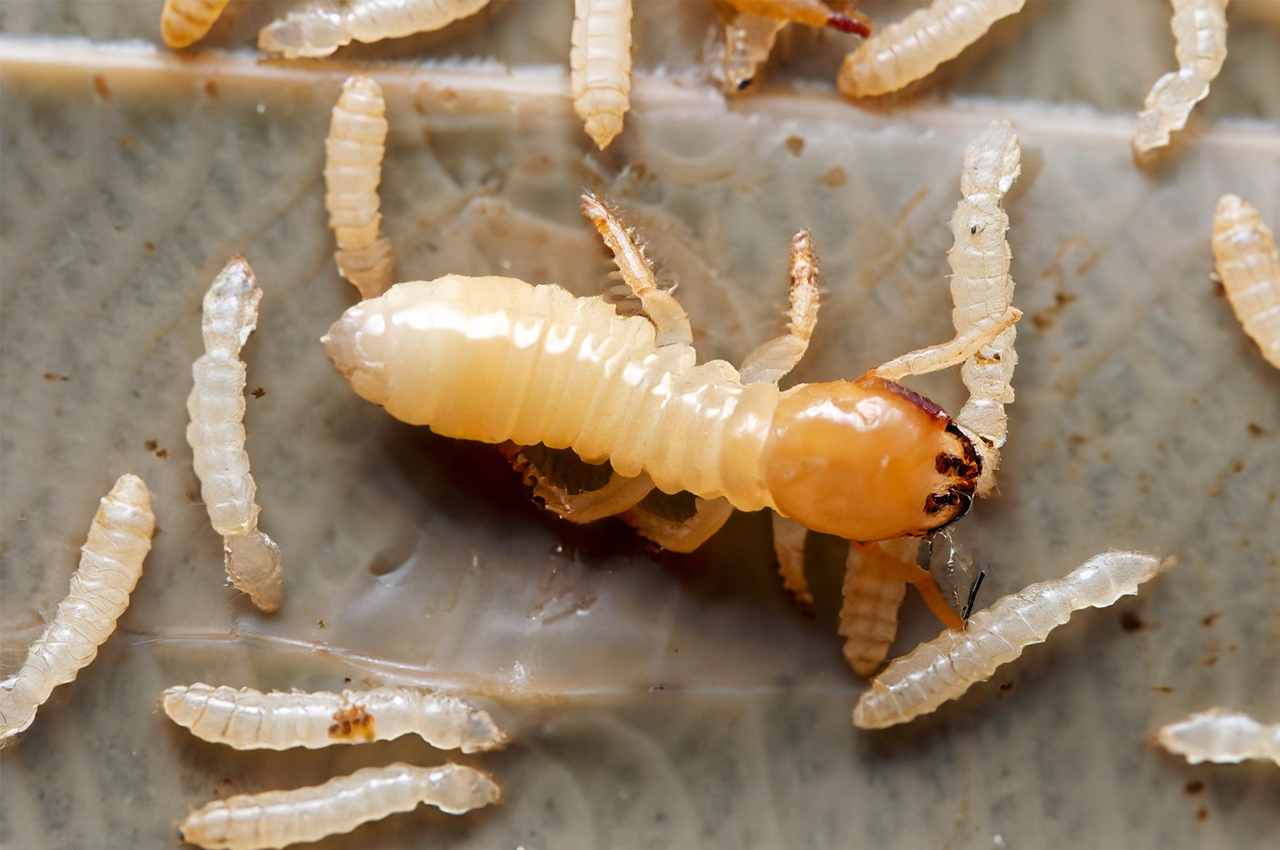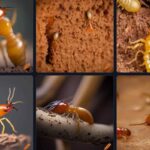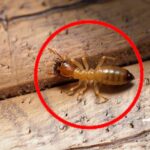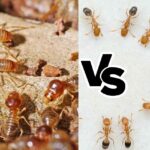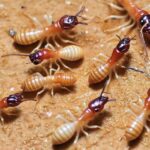Learning how to identify termite larvae is crucial for homeowners concerned about potential infestations. If termites are not controlled, they may seriously harm buildings and houses. The early detection and treatment of termite infestations depend heavily on the ability to recognize termite larvae. Detailed information on distinguishing termite larvae from other insect larvae, such as their appearance, size, and location, will be provided in this guide.
How to Identify Termite Larvae?
Termite larvae are soft-bodied and almost translucent white in color. They have six legs and a unique head capsule. On a smaller scale, the larvae resemble adult worker termites. Termite larvae characteristics include:
- Color – Translucent white or cream. Soft-bodied.
- Size – Approximately 1/10 inch (2.5 mm) long.
- Body – Grub-like, lacking wings. Distinct head capsule.
- Legs – Six legs present.
- Antennae – Straight antennae.
Despite being considerably smaller in size, termite larvae resemble worker and nymph termites very closely. At this point, the larvae are not completely formed.
Characteristics of Termite Larvae
| Characteristic | Description |
|---|---|
| Color | White, almost translucent |
| Size | Approximately 1/10″ |
| Appearance | Resemble worker termites |
| Location | Found in termite mounds |
| Feeding Behavior | Fed by adult termites |
| Molting | Transform into workers or nymphs |
How Big Are Termite Larvae?
Termite larvae are quite tiny, with lengths of less than 1/10 of an inch (2.5 mm). For reference, an adult worker termite measures around 1/4 inch (6.4 mm) in size.
The normal sizes of termite larvae at various development stages are as follows:
- Newly hatched – About 0.04 inches (1 mm)
- Early instars – Up to 0.08 inches (2 mm)
- Late instars – Around 0.10 inches (2.5 mm)
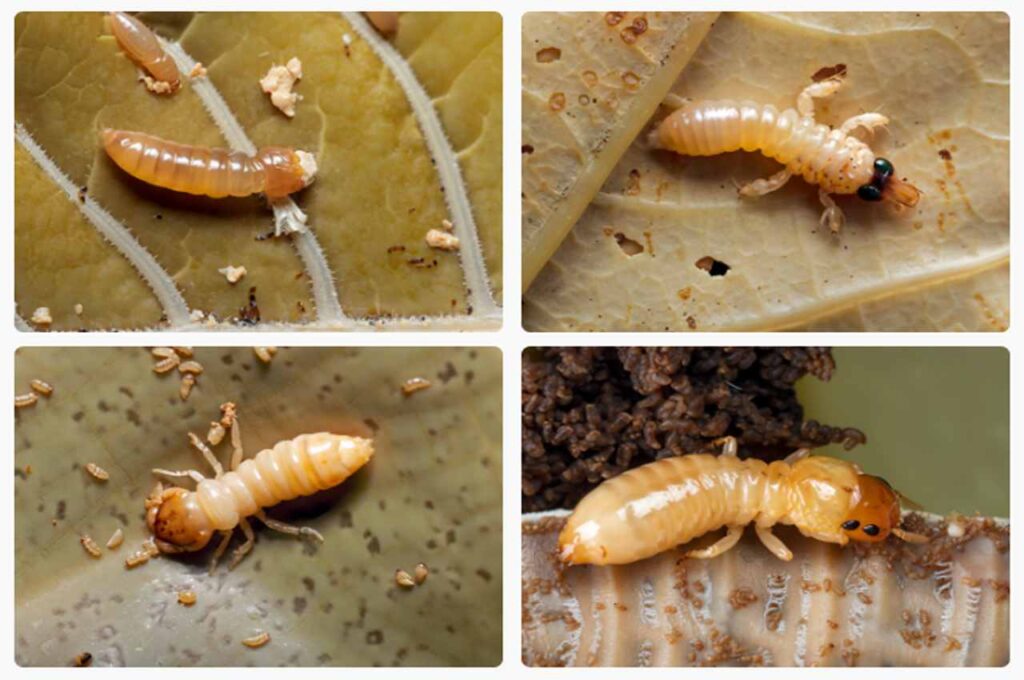
The tiny white eggs from which termite larvae emerge in the colony are around the same size. When originally deposited, the eggs are barely 0.01 to 0.04 inches (0.25 to 1 mm) in size.
Subterranean Termite Larvae
Looking for underground termite larvae? While these bugs do harm underneath, finding larvae within the house indicates that there is an active subsurface infestation. Subterranean termite larvae resemble small, pale termites and share the following characteristics:
- Very small, less than 1/10 inch (2.5 mm)
- Soft, white, translucent bodies
- Visible head capsule
- Six legs present
- Resemble miniature worker termites
In contrast to the immature larvae, young worker termites have darker heads and harder jaws for eating. Soldiers may be recognized by their darker, harder skulls.
Where are Subterranean Termite Larvae Found?
Larvae grow underground in the center nest outside. Termites either construct mud nests that are tied to foundations or they house colonies in pre-existing cavities close to wood food supplies. In protected galleries, workers care to the larvae.
In buildings, mud tubes placed over the foundations may be used to transport larvae within. If an interior nest has been built in a wall void or another appropriate hollow, larvae may also be discovered there. These indoor nests have nursery chambers constructed deep within.
Signs of a Subterranean Larvae Infestation
Clues that larvae may reside within your home:
- Mud tubes on exterior walls or crawlspace
- Hollow drywall damage
- Sagging floors
- Moldy odor
- Piles of wings or pellets around windows
- Cracks along the foundation
Finding larvae inside a residence indicates that there is an active nest there that has to be treated by an expert.
Getting Rid of Subterranean Termite Larvae
The following recommendations for treating subterranean termite larvae:
- Soil treatment- Drench the area surrounding and under the foundation with termiticide to kill any larvae.
- Bait system – Larvae nests are removed from the interior via in-ground bait stations.
- Fumigation – Seals the building so that the fumigant may enter secret passages filled with larvae.
- Targeted spraying – Apply spot treatments where larvae are apparent or suspected.
Fumigation or a mix of techniques is advised for the best outcomes. It is suggested that you get an examination and a site-specific strategy from a pest control expert.
Preventing Subterranean Termite Larvae Infestations
- Fix moisture problems including leaks, puddles, and condensation.
- Check the foundation’s surrounding drainage.
- Eliminate any wood scraps and formboards that are in contact with the structure.
- Open windows in basements and other moist locations.
- Seal up any potential access spots and external cracks.
- Apply a borate solution on wood that is next to soil.
- Request regular checks from experts.
These harmful pests may be prevented by catching larvae early and removing favorable circumstances for their colonies.
Drywood Termite Larvae
Drywood termites are very cunning house destroyers. Years may pass before the harm they do is discovered as they softly consume wood. One of the greatest early warning signs that these pests have entered your house is the presence of drywood termite larvae. How to spot them is as follows:
Appearance of Drywood Termite Larvae
The larvae of drywood termites resemble young, immature worker termites in size. Important characteristics:
- Very small, about 1/10 inch (2.5 mm)
- Soft, white, translucent bodies
- Head capsule is slightly darker
- Six legs present
- Resemble ants, but with straight waist
They resemble adult drywood termites in terms of their fundamental body form, as opposed to other species’ larvae, which resemble maggots more. Drywood larvae are just scaled-down replicas of termite adults.
Where to Find Drywood Termite Larvae
Drywood termites often build their nests deep into a house’s timber framework. Larvae grow within galleries that have been bitten out of contaminated wood. Pristine areas include:
- Attics
- Wall voids
- Ceilings
- Wooden trim
- Flooring
- Furniture
Larvae of dry wood won’t leave the galleries. Workers close nursery to preserve temperature and humidity.As a result, if extensively contaminated wood is broken open, larvae are most likely to be found.
Drywood Larvae Activity Indicators
- Some signs that drywood termite larvae may be present:
- Tiny pinholes in wood surfaces
- Powdery pellets (frass) near wood
- Discarded wings from swarms
- Hollow drywall or wood
- Paint bubbling on wood surfaces
These indicators, together with real larval observations, indicate an active infestation that requires control.
Getting Rid of Drywood Termite Larvae
To control drywood termites before colonies take off, larvae must be eradicated. Options for treatment include:
- Fumigation – Seals structure to fill with deadly gas as larvae penetrate galleries.
- Heat – Heat kills the larvae within infested wood when it reaches 120°F or above.
- Spot treatments: Applied spray or dust to larval galleries that are easily accessible.
- Wood injection – Inserting termiticide via tiny holes drilled into infected wood.
- Wood replacement – If required, physically remove wood that has been extensively infected.
In most cases, a combination of techniques is needed to completely eradicate drywood larvae. A skilled pest control specialist can identify regions where larvae are present and design a customized treatment strategy.
Termite larvae prevention for dry wood
To prevent drywood termite larvae from getting into your house:
- Check each week for symptoms like fecal pellets.
- Quickly address roof and pipe leaks
- Ventilate crawl areas and attics
- To lower humidity, filter the attic air.
- Fill up gaps around windows and doors
- Seal cracks in external woodwork.
- Apply a borate solution to wood that is vulnerable.
These covert nesters may be discouraged by reducing moisture and blocking off access openings. But the key to avoiding significant drywood termite damage is routine inspections and prompt response to any evidence of larval activity.
Dampwood Termite Larvae
Termites that live in damp, decaying wood flourish there. Their larvae grow in secret inside wet wood before emerging as adults to widen the galleries of rot. To recognize dampwood termite larvae, follow these steps:
What Do Larvae of Dampwood Termites Look Like?
The larvae of dampwood termites resemble small, immature worker termites. They have a similar overall body type. Identifying characteristics include:
- Very small, about 1/10 inch (2.5 mm) long
- Soft, white, translucent bodies
- Visible head capsule
- Six legs present
- Lack hardened jaws or darkened heads
The light hue and body type of mature dampwood termites are essentially mirrored in the dampwood larvae look, however on a lesser scale before complete maturity.
Where Are Dampwood Termite Larvae Found?
For building nest galleries, dampwood termites seek consistently moist, decomposing wood. Within these contaminated places, larvae grow. Important areas to look are:
- Rotting tree stumps and logs
- Exterior wood siding
- Wood retaining walls
- Fence posts
- Structural timbers
- Bathroom walls near leaky plumbing
While workers maintain the galleries molded and degraded enough to travel through and spread, larvae flourish in the moist circumstances.
Signs of a Dampwood Larvae Infestation
Clues that dampwood termite larvae may be present:
- Wood surfaces appearing wet or discolored by fungus
- Soft, crumbly wood
- Wilting plants or grass nearby
- Moldy odor from wood
- Temporary mud shelter tubes on walls
- Shedding wings around windows
Both these warning indicators and the presence of larvae suggest that a dampwood termite colony is active and in need of treatment.
Getting Rid of Dampwood Termite Larvae
The following are suggested remedies for dampwood termite larvae:
- Fumigation: A building is sealed off and flooded with deadly gas to reach below chambers.
- Wood injection – Termiticide is injected into larvae-harboring galleries by drilling infected wood.
- Wood replacement – Taking out the physically infested wood.
- Moisture reduction – Reducing moisture through repairing leaks, enhancing drainage, and ventilation wet areas.
The recommended approach is to combine targeted wood treatments, moisture reduction, and fumigation. A expert in pest treatment should be consulted.
Preventing Dampwood Termite Larvae
To prevent future infestations with dampwood termite larvae:
- Quickly fix plumbing leaks and moisture buildup.
- Make property drainage improvements
- Add ventilation to basements, attics, and crawl spaces.
- Get rid of wood waste and stumps
- Make sure that the house is not in contact with any mulch or firewood.
- Fill exterior gaps and cracks
- Apply a borate solution to wood that is vulnerable.
To stop these invasive pests from causing significant harm, it’s important to catch larvae early and address moisture problems.
Where Are Termite Larvae Found?
Termite larvae are hidden deep within the colony nest, out of the path of light and any predators. In the nursery chambers that the worker termites constructed, the eggs develop into larvae. The workers feed and tend to the larvae while they remain within these secure nurseries.
The late instar larvae enter the main nest galleries and tunnels where they continue to grow as they become bigger. However, since workers protect them within the nest, you will seldom ever find larvae outside of it or in exposed regions.
| Location | Common Areas to Check |
|---|---|
| Exterior | Window sills, frames, door frames |
| Interior | Support beams, concrete-wood joints |
| Moist Areas | Basements, crawl spaces, porches |
| Hidden Spaces | Cracks, dark corners, within walls |
| Signs of Activity | Hollow or rustling sounds in wood |
| Mud Tubes | Look for tubes on walls or foundation |
| Consult Professionals | Pest control experts for deep checks |
Can You Find Termite Larvae Outside?
It’s unusual to see termite larvae outside of the nest. Their presence suggests a significant termite infestation within the building. Here are few cues that suggest there may be outside larvae:
- Larvae creeping on foundation walls or outside walls
- Mud tubes contain larvae
- Larvae appearing in window frames or nooks and crannies
- Outdoor pheromone traps collected larvae
The nest may be overcrowded and fresh reproductive termites may be seeking to form satellite colonies nearby if larvae are seen outdoors.
Do Termite Larvae Cause Damage?
Even while larvae don’t really harm wood, their presence signals a flourishing colony with many active workers. There will be more adult termites digging, eating, and endangering structural integrity the more larvae there are in a colony.
Eliminating larval nests is essential for halting infestations before they spread. If larvae are allowed to develop uncontrolled, they will grow to be thousands of destructive workers.
Termite Larvae vs. Other Insect Larvae
| Insect Type | Appearance | Color | Size | Legs and Eyes |
|---|---|---|---|---|
| Termite Larvae | Resemble workers, white | White, translucent | Approximately 1/10" | Yes |
| Ant Larvae | Grubs, no legs or eyes | Varies | Varies | No |
| Maggots | Tube-like body, no distinct head | White | Varies | No |
| Powderpost Beetle Larvae | C-shaped, spines on back | Darker with spines | Small, C-shaped | Yes |
| Psocids (Booklice) | Small, white, covered in tiny hairs | White | 1/16" to 1/8" | No |
Termite Larvae vs Maggots
Termite larvae and maggots (fly larvae) are white with soft bodies, but they vary in many ways. Termite larvae have a distinct head, whereas maggot heads blend in. Though maggots may develop to 1/2 inch, termite larvae are usually less than 1/10 inch. Termite larvae are elongated, whereas maggots are cylindrical. Most notable is the growth of termite larvae into adult termites and maggots into flies. Termite larvae are fed by worker termites in termite colonies, whereas maggots are found in decaying organic waste like old food or plants. Some maggot species have decreased or no legs, therefore leg count alone can not differentiate the two.
| Characteristic | Termite Larvae | Maggots |
|---|---|---|
| Appearance | White with a distinct head | White with an indistinct head |
| Size | < 1/10 inch (2.5 mm) | ~ 1/2 inch |
| Body Shape | Tubular, elongated | Rounded, cylindrical |
| Development | Grow into adult termites | Develop into flies |
| Habitat | Found in termite colonies | Found in rotting material |
| Legs | Do not have visible legs | May have visible legs |
Maggots are young flies. They resemble worms and lack legs, which contrasts with the distinctive body form of termite larvae.
Termite larvae vs ant larvae
| Characteristic | Termite Larvae | Ant Larvae |
|---|---|---|
| Appearance | Resemble smaller versions of adult termites | Resemble tiny tubes of rice |
| Body Shape | Tubular, often smaller and elongated | Cylindrical |
| Habitat | Found in termite colonies | Found in ant colonies |
| Life Cycle | Egg, larva, nymph, and adult stages | Egg, larva, pupa, and adult stages |
| Antennae | Have antennae | Do not have visible antennae |
| Waist | Rectangular body shape, no narrowing | Narrow, constricted waist |
Although termites and ants might have similar adult appearances, their larvae seem quite different. Termite larvae look like little termite workers. Ant larvae resemble maggots and have no legs.
Termite larvae vs carpenter ant larvae
| Characteristic | Termite Larvae | Carpenter Ant Larvae |
|---|---|---|
| Appearance | Resemble smaller versions of adult termites | White, small, legless, and grub-like |
| Body Shape | Tubular, often smaller and elongated | Cylindrical |
| Habitat | Found in termite colonies | Found in carpenter ant colonies |
| Life Cycle | Egg, larva, nymph, and adult stages | Egg, larva, pupa, and adult stages |
| Antennae | Have antennae | Do not have visible antennae |
| Behavior | Feed on cellulose, including wood | Excavate wood to create nests |
Termite Larvae vs Beetle Larvae
- Termites – Soft-bodied, straight antennae, six legs.
- Beetles – Harder bodies, may have hairs or extra legs.
Larvae of beetles, such as those seen on powderposts, have more robust exoskeletons and additional appendages like hairs and legs. Comparatively, the bodies of termite larvae are uniformly soft.
Termite Larvae Development and Life Cycle
Termite larvae undergo a straightforward metamorphosis and divide into several castes depending on the requirements of the colony. These are the first phases:
1. Egg: The nest’s existing nursery chambers are where female alates deposit their eggs.
2. Larva: Larvae with a soft body develop from eggs. They are fed and cared after by workers.
3. Nymph: To become nymphs, larvae molt. Nymphs develop into a variety of castes.
4. Adult: Adult worker termites, soldiers, or wingless reproductive alates evolve from nymphs.
According on the needs of the colony, termite larvae may metamorphose into workers, soldiers, or reproductive nymphs. Most of them strive to maintain and grow the nest as employees. Eventually, some of them become winged alates that go on to establish new colonies.
| Stage | Description |
|---|---|
| Mating | Reproductive termites leave nest to procreate |
| Egg and Larvae | Queen lays eggs, which hatch into small, white larvae |
| Molting | Larvae molt and become nymphs or workers |
| Maturity | Termites develop into various castes |
Termite Larvae Infestation Warning Signs
The following symptoms might point to the existence of an active colony of termite larvae:
- Foundation walls with obvious termite mud tubes or shelter tubes.
- Tiny holes in drywall or wood the size of pinholes.
- Termite wings left behind around doors and windows.
- Frass (termite droppings that resemble pellets) next to wood trim or beams.
- Hollow noises when tapping on wooden surfaces.
- Ceilings, staircases, or floors that are sagging.
The presence of larvae within the house confirms an infestation that has to be treated based on these symptoms.
Termite Larvae Removal Methods
There are many ways to exterminate termite larvae. The optimal strategy depends on the termite infestation type, intensity, and larval placement.
Professional Ways to remove termite larvae
- Chemicals are best for termite larvae removal. Chemical termiticides are available, and the optimal one depends on the scenario. Chemical termiticides may be applied to the foundation soil, the interior, or both.
- Baiting systems: Another successful termite larva removal method is baiting. Home baiting systems use bait stations throughout the house. The bait attracts termites, who bring it back to the colony. Slow-acting poison in bait destroys the colony.
- Fumigation is the most extreme termite elimination approach, yet it works best. Fumigation kills all termites in the house using harmful gas. Fumigation is usually reserved for serious termite infestations.
Natural Termite Larvae Removal
Natural termite larva removal strategies exist in addition to chemical and mechanical ones. These treatments are less successful than chemical ones, but they may complement chemical treatment or treat tiny termite infestations. A few natural termite elimination methods:
- Boric acid: Termites are poisoned by the natural compound known as boric acid. It may be put to the home’s foundation soil or inside.
- Essential oils: Orange and neem oils are insecticidal. They destroy termites and prevent their reappearance when sprayed.
- Beneficial nematodes: Microscopic termite-eating worms. These may be put to the soil surrounding the home’s foundation to combat termites.
Call a pest control firm to discuss termite treatment if you have an infestation. Professional pest control companies may evaluate the infestation and propose the best remedy.
Additional termite larvae removal tips:
- Remove standing water and leaking pipes from your property. Destroying moisture sources will make your property less appealing to termites.
- Seal foundation cracks and window and door apertures. This prevents termites from accessing your house.
- Visit your house often for termite indicators. Mud tubes, frass, and other termite damage should be looked for. Termites should be reported to a pest control provider immediately.
Typically, a combination of techniques is required to completely eradicate termite larvae nests and stop further infestations.
Termite larvae infestation prevention
Following are some suggestions to assist stop termite larval colonies from growing within your house:
- Take care of moisture problems, such as leaks, condensation, and standing water.
- Check for good drainage surrounding the building.
- Add ventilation to basements, attics, and crawl spaces.
- Keep debris, such as firewood, away from the walls of the foundation.
- When near soil, use treated timber.
- Fill up foamy entrance sites and cracks along external walls.
- Request regular inspections from a pest control expert.
You may lessen the possibility of termite larvae infestations by being vigilant and doing preventive maintenance. However, act to eradicate termite larvae as soon as you see an active colony to prevent further harm.
Frequently Asked Questions
What color are termite larvae?
Termite larvae are generally white and nearly translucent in color, displaying soft and pale bodies. They look like miniature worker termites. Termite larvae look identical to mature worker and nymph termites, making it difficult to recognize them by color. To accurately identify termite larvae and comprehend their function in the colony, it’s important to examine additional qualities and aspects than color.
What do termite larvae look like?

Termite larvae are very small, about 1/10 inch (2.5 mm) long with soft, white, translucent bodies. They have six legs and an apparent head capsule. Due to the lack of completely formed characteristics like darker heads or firm jaws, termite larvae closely resemble small worker termites. The larvae have undeveloped body parts and resemble tiny counterparts of adult termites.
What do termite eggs look like?
The termite egg is tiny, round, and white or translucent. The queen guards them deep in the termite nest until they hatch. These transparent eggs seem like little white pellets or jelly beans with no visible dents or dips. Depending on the species, termites lay hundreds to thousands of eggs in clusters. These clusters might seem like little caviar or grains. Average termite egg size is 0.5 mm. Termite eggs vary in color, with the first batch deposited by a queen being somewhat yellowish and succeeding batches being white or off-white.
What are the characteristics of termite larvae?
Termite larvae are a crucial stage in the termite life cycle, immediately following the hatching of termite eggs. They may be distinguished by their almost translucent white color and microscopic size, which are reminiscent to termite eggs. These soft, white larvae resemble tiny termite workers. They have a large head, a smooth body, and antennae that are straight. They lack the characteristics of the caste members they will become, while seeming to be adult termites. Termite larvae consume cellulose, much as adults do, but they need worker termites to break it down. Sand, bits of wood, and other organic materials are linked together by the saliva of termite workers to form termite mounds, which serve as the colony’s main nest. There, the larvae are found.
What kills termite larva?
It is essential to deal with the whole colony and, more importantly, get rid of the worker termites that look after and protect the termite larvae in order to destroy them. The best method is to hire a pest control specialist who has the skills and equipment to spray termiticides or insecticides that kill termites. Alternatives include termite killers that may be applied according to directions and are safe for people but need gloves. Using sodium borate and borax powder or termite traps to catch and destroy termites are other approaches. Physical nest destruction is feasible, although termiticides or pesticides are advised for better control. Some DIY termite control methods include spraying a 1:1 vinegar-water combination on suspicious locations or utilizing water. However, removing termite infestations, particularly larvae, requires thorough techniques, and a professional pest control service is frequently the best approach to achieve total eradication.
Do termite larvae fly?
No, termite larvae cannot fly. Swarmers, or flying termites, are adult reproductive termites with wings and eyes to swarm and start new colonies. Newly born termite larvae have not yet molted into worker, soldier, or reproductive termites. Later in termite development, some larvae molt into primary reproductives, which may fly and create new colonies.
Do termite larvae eat wood?
Yes, termite larvae do indeed consume wood as part of their diet. Like adult termites, termite larvae eat cellulose from wood, paper, plants, sheetrock, and other cellulose-containing materials. They differ from others because they need worker termites to digest. Worker termites’ stomach bacteria and protozoa create cellulose-degrading enzymes. The larvae get these enzymes via mouth-to-mouth feeding. Some termite species prefer wood that has begun to break down owing to fungal activity, making digesting easier. Thus, while termite larvae eat wood, worker termites help them digest this cellulose-rich meal.
Can termite larvae live in water?
There is no proof that termite larvae can survive in water. Some studies have examined termite tolerance to salt and temperature, but none have examined termite larvae in watery habitats. Termites may vary in tolerance, but termite larvae, like their adult counterparts, need a dry habitat to live. These investigations show that termites have adapted to certain environments but do not prove that larvae can thrive in water.
Do ants eat termite larvae?
Yes, ants are indeed predators of termites, including termite larvae. Ants eat termites for their protein. Ants initially feed termites to their larvae since they cannot digest them. After ant larvae digest termite corpses, worker and queen ants eat the nutrients. Ants are natural termite rivals and regularly attack termite nests to reduce resource competition. Not all ant species eat termites, but many do, including their larvae. In termite infestations, ants are strong predators.
What's the difference between termite larvae and worker termites?
Although termite larvae and worker termites seem same, there are several major distinctions. The average termite larva is 1/10 inch long. Worker size is 1/4″. Workers have stiff mandibles and black heads, whereas larvae are softer and paler. The larvae seem like little termites because their heads, jaws, and bodies are still growing.
Where do termite larvae live?
Termite larvae are located deep inside the central colony nest. Working termites build and maintain nursery chambers where eggs hatch into larvae. Larvae seldom leave the nest until later instars. Workers accompany late-stage larvae as they work outside protected nurseries. Termite larvae moving outside the nest are rare and indicate a major infestation.
Can you find termite larvae in mud tubes?
Although it is rare to observe larvae outdoors, they may sometimes be seen within the mud tubes that workers build to move about the nest. Workers transfer larvae to extend the nest’s edge, protected by tubes. Breaking apart a tube and seeing little soft-bodied larvae indicates an active infestation that needs treatment. Finding larvae in mud tubes or outdoors is unusual.
What are the signs of a termite larvae infestation?
Mud tubes on walls and foundations, pinholes in drywall, abandoned wings around windows and doors, hollow damaged wood, and frass pellets near wood may indicate termite larvae. These signs, together with seeing the little creamy larvae, indicate an active infestation that needs expert treatment and eradication. If larvae are within living areas, the colony has broken in.
How do you get rid of termite larvae?
Depending on the infestation and termite type, numerous treatments may eliminate termite larvae. The most typical methods include chemical termiticides sprayed to soil or within the house, baiting systems that utilize slow-acting poisons to kill the colony, and fumigation for severe infestations, heat treatments, and specific wood treatments are all viable treatment methods. Naturally, boric acid around the foundation or indoors, essential oils like orange or neem oil to repel and kill termites, and beneficial soil nematodes that prey on termites can complement chemical treatments or treat minor infestations. By getting rid of the larvae before they develop into wood-devouring adults, more harm may be avoided. In order to completely eradicate larval nests, an integrated pest control strategy is often needed.
Can termite larvae move?
Termite larvae do have the ability to move, although they do so relatively slowly. They remain close to the colony and wood they eat in their early stages. While maggots loop, termite larvae go straight. Worker termites provide wood cellulose for these larvae to thrive. They molt many times to grow into workers, soldiers, or reproductives, depending on the colony’s needs.
- How do termite mounds help regulate temperature? - 7 January 2024
- 10 Effective Termite Control Methods That Actually Work - 4 January 2024
- How Long Does It Take for a Termite Mound to Form? - 21 December 2023
